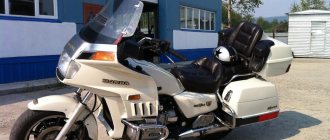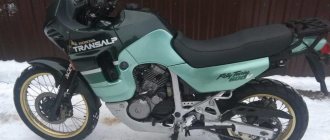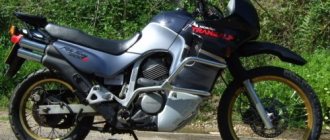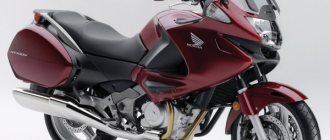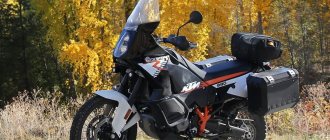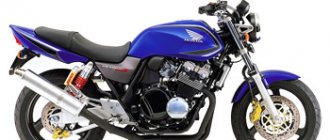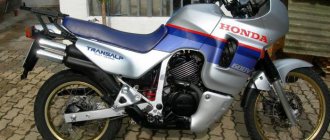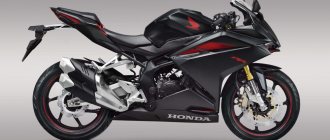Bike features
Honda XL 700 V Transalp has the following characteristic features:
- as much as 60 Newton meters and 60 horsepower for the engine;
- although the bike weakened as an SUV, its road properties improved;
- The fuel tank has become less spacious.
In general, despite some disadvantages and features, this model turned out to be worthy of becoming the final one in the famous Transalp motorcycle series. Is she the best? Definitely not, and in general, each representative of the series had its own special advantages.
Brief history of the model
Model
: Honda Transalp 600 (Europe, Japan).
Factory designation
: XL600VH.
Model
: Honda Transalp 600 (Europe).
Factory designation
: XL600VJ.
Model
: Honda Transalp 600 (Europe, North America).
Factory designation
: XL600VK, XL600V A / XL600V AC.
Model
: Honda Transalp 600 (Europe, North America).
Factory designation
: XL600VL, XL600V A / XL600V AC.
Model
:Honda Transalp 600 (Europe).
Factory designation
: XL600VM.
Model
: Honda Transalp 600 (Europe).
Factory designation
: XL600VN.
Model
: Honda Transalp 600 (Europe).
Factory designation
: XL600VP.
Model
: Honda Transalp 600 (Europe).
Factory designation
: XL600VR.
- 1995 – model not produced.
- 1996 - the spacer was removed from the front fork, and the spring was replaced with a longer one. Two ignition coils per cylinder are replaced by one per cylinder.
Model
: Honda Transalp 600 (Europe).
Factory designation
: XL600VT.
Model
: Honda Transalp 600 (Europe).
Factory designation
: XL600VV.
Model
: Honda Transalp 600 (Europe).
Factory designation
: XL600VW.
Model
: Honda Transalp 600 (Europe).
Factory designation
: XL600VX.
Engine
The engine here is four-stroke and two-cylinder. It is V-shaped in type, which has already become a characteristic feature of the entire series. The working volume falls short of seven hundred and is 680 cm³. The unit cools the liquid. There are 4 valves per cylinder, and the fuel supply system of the XL 700 V is injection.
The maximum performance of the model is as follows: at 5500 rpm the torque is 60 Nm, and at 7750 the power reaches 60 hp. The speed figures are not particularly impressive, but quite good: the top speed of which the XL 700 V is capable reaches 172 km/h, and it accelerates to 100 km/h in 5.1 seconds.
Test drive HondaXL 700 V Transalp
This often happens when a manufacturer, under the pressure of persistently advancing technological progress, tightening emission standards and the instigations of marketers, is forced to change a model that has already become a LEGEND. The new product is examined through a magnifying glass, first by journalists, and then by potential buyers, involuntarily comparing it with its predecessor, which has already received recognition, and looking for all sorts of “fleas”. Let's not be original. You can imagine how I, who rode a Honda XL650V Transalp for two seasons and literally fell in love with this motorcycle, was incredibly interested in taking the opportunity to run my fingers through the “fur” of its successor, the XL700V, which retained the proud name of Transalp.
Opinion: Valera DRIVE
(height 186 cm, weight 125 kg)
Rides a Suzuki V-Strom DL1000
When I examined the “newbie” for the first time last fall (at the EICMA-2007 exhibition), I couldn’t help but think that general globalization, urbanization and even the introduced freedoms for sexual minorities influenced Honda marketers: the new Transalp became even larger with the prefix “uni” "
I read the technical specifications: the front wheel is 19" instead of 21", the wheelbase is shortened, the suspension travel and tank volume are reduced. What, “back to the future”? If the previous Transalp was already called a “SUV”, then what can we say about this?
These are the thoughts I approached the test motorcycle with. Having inserted the key into the unchanged ignition switch (with the same proprietary HISS anti-theft system), he turned it. The tidy, joyfully coming to life, began the countdown: the numbers on the large digital speedometer began to decrease, from the maximum speed to zero. Already funny! I was also pleased with the ABS warning light, which went out after starting to move, but before it didn’t exist at all, since there was no system itself. The large tachometer was left analog, and its readings were made better readable on the go. I thought that they raised the bar for the “red zone”, because the engine was greatly updated, increasing the displacement and equipping it with an injector, but no: “Vashki” do not like high speeds, and apparently they even decided to lower the “bar” somewhat (8000 instead of 8300 on the XL650V ). (Looking ahead, I’ll say: while driving, the new engine still feels like it’s running at a higher speed). Let's start. I immediately noticed that the new engine was louder than the old one. Moreover, this in no way relates to exhaust volume, no. I mean the noise of the motor itself, as a unit. With a sharp addition of “gas”, it seems that even flashes in the cylinders are heard, although in my mind I understand that it is impossible to hear them. Surely the engine was lightened - it looks sleeker than its predecessor, not a trace remains of the former cooling fins, so the natural sound insulation was somewhat weakened. Plus, fuel injection made its contribution - it has long been known that injection engines work harder than “carb” engines. This is very annoying in the city. But how does he drive?
I didn’t expect such agility from a “mid-sized ship”! They clearly “worked closely” on it, redistributing the torque. The old “veshka”, which has its roots in the chopper, back in the distant 80s of the last century, did not have such an easy ride. Here the crankshaft spins up so quickly that it’s easy not to notice how the tachometer needle crosses o, and the motorcycle is still running in! We can say for sure: the score is 1:0 in favor of the newcomer, because dynamics was the “Achilles heel” of his predecessor. The only negative is the high-frequency vibrations that appear in the o area and penetrate everywhere - from the handlebars and footrests to, excuse me, your ass. The predecessor was not without a similar drawback, but there small (namely, they are especially nasty and annoying) vibrations arose at higher speeds and bothered only during long driving at speeds of “135 km/h and above.” For the “new” one, this is the most “working” speed range. Here the “old man” rightly gets one point.
As they say, “without leaving the cash register,” I also had to evaluate the advantages of the optionally installed high glass: the digital speedometer proudly showed the figure “140 km/h” (to which the XL650V goes long and hard, like a climber conquering Everest), and on this Speeds with standard glass on both models are seriously blown away. And then the crazy idea came to my mind to simulate an emergency situation and perform emergency braking. Glancing at the rearview mirrors (God protects the safe!), I carry out my plans. The elastic vibration of the brake lever and paw made it clear that the ABS immediately began to work. Wow, what a slowdown! Now I understand why they reduced the travel of the front fork - with such brakes, the closer the suspension parameters are to road ones, the better!
2:1, the newcomer passed the brake test with an A plus, because it is known that the old Transalp, having received two front discs, had a tendency to lock the front wheel (especially on slippery surfaces). But the fact that ABS performed well in emergency braking on asphalt is not yet an indicator, a savvy reader may object. After all, there is no button to turn it off, but how will the system behave when braking on the ground or sand? We checked. Well behaved! Soft operation during careful braking allows you to use it off-road - this is another extra point for the XL700V, because previously, using the rather powerful front brake of the 650 on the ground often led to the front wheel locking and falling. It should be honestly admitted that there is an even cheaper (the difference is about 900 euros) version of the XL700V Transalp, it is without ABS, but since the official importer of Honda, MotoMir LLC, does not plan to import such a Transalp to Ukraine, until the situation changes, you can Don't worry about its braking performance.
It’s time to say something about the ease of landing, but here, alas, I was unlucky: the “test” had an option that goes against my height - a lower landing height, so there will be no points here: after all, after replacing the standard steering wheel with The “650” is tall, with a jumper, its ergonomics satisfied me “100 percent”. But for short drivers (especially women), this option is a clear plus.
But it’s time to move on to the main thing: the behavior of the motorcycle in its natural habitat, which, judging by the official press release of the manufacturing company, is very diverse (city, suburbs, highway and approaches to “nature”). Moreover, in order of importance – in that order. Honda, preparing for production of the new Transalp, conducted a series of marketing studies, during which a lot of interesting things emerged, in particular, the fact that the vast majority of XL650V owners NEVER went off-road, content with moving around the city, on paved roads, or, at worst, end, hard primers. Moreover, when buying Transalp, they did not even count on its off-road operation, although, of course, they took into account its main ability - to comfortably overcome roads of average and poor quality. So this is where the “dog is buried”! Honda, having sensibly reasoned in the manner of “why does a hare have a brake light?”, decided to make some resection of the “extra” off-road “ballast”, while significantly improving the purely road-touring characteristics of the device (dynamics, comfort, handling, brakes). What happened in practice? The new Transalp really has not lost face and is not afraid of uneven roads, edges, or conditional off-road conditions in the form of grass or dirt paths, but it instantly gives way in mud and loose sand. In urban conditions, it also did not disappoint: it storms holes, curbs, joints, rails and other urban irregularities even more smoothly than its predecessor, which was easy to compare, since right there, as they say, “in the bushes,” was the one I had just brought from Germany Transalp 2002 release. The handling of the “newbie” also turned out to be a cut above – some of the smearing of the chassis inherent in the “650” has disappeared, it dives into turns more willingly and rises faster at the exit from them “from the handle” - after all, the engine output has also improved. As for the comfort of the driver and passenger, the score is 0:0, since I did not notice any significant improvement or deterioration in this indicator.
But the XL700V has a “trump card” in its pocket – it’s efficiency! The carburetor Transalp easily “ate” 8 liters of 92-octane gasoline in city mode. Now this figure has dropped by almost one and a half times, and on the highway the XL700V will be able to boast a real consumption of less than 4 liters per “hundred” (though already “95th” and at a cruising speed of 90 km/h), which was unattainable for the previous models. On average, the “new” one consumes 40% less fuel, which is why they installed a smaller tank (the “old” one held 19.5 liters, but now only 17.5). But, I think, this is not at all critical, since there was no real reduction in the power reserve, and specific fuel consumption makes it possible to really save money.
Well, we can summarize: technological progress, as well as the tightening of emission standards, are inevitable, and sooner or later, but all “carburetors” will die out, just like the dinosaurs died out, and this should be treated philosophically. The new Transalp turned out to be expensive (it costs 15,000 UAH more than the new carburetor XL650V of the last year of production without ABS), but it has become clearly better and more functional for road use than its predecessor, although it still lost the feature still inherent in the latter, wearing special tires, fly up a dune, “muddy” rural dirt roads, or ford a stream/river. So for those who are going to use the Transalp as a full-fledged (that is, with off-road “skills”) enduro-tourer, it makes sense to look for the old version while they are on sale on the secondary market, but for others who value active safety and efficiency and the dynamic capabilities of a universal motorcycle are higher than its off-road qualities, it’s time to spend money on the “new one”. In any case, it’s good that there is still a choice, because the situation with another legendary model from Honda, the XR750V Africa Twin, is more sad: in 2003 its production simply stopped, and consumers received nothing in return and now the “Africa” has become a super-scarce motorcycle...
Opinion: Vlad VORTEX
(height: 180 cm, weight: 73 kg)
Rides a Kawasaki ER-5 Twister
22 years ago, Honda released the first version of Transalp - the XL600V model. It was a fairly simple motorcycle with a V-twin engine, borrowed from a chopper, but tailored in the image and likeness of the “primitive enduro”, XLV750R Transalp, which for two years in a row took prizes in the Paris-Dakar rally raid. In those years, the advantage of V-twins in such competitions was undeniable. The slightly greater weight (compared to single-barreled guns) was compensated by greater power output and reliability. And the “civilian” XL600V was endowed with the same advantages. Thanks to good handling and high (in its class) power, the motorcycle held a leading position in the race for buyers for a long time. The subsequent few modernizations mainly concerned changes in the design and modification of the brakes, a small increase in displacement and power (the XL650V model was produced for the last 8 years). But last year, the company decided to turn the former “all-passenger” into something like a “SUV”.
Before the start of the test, I still thought that the new Transalp had at least something left of those former champions. The previous model was definitely still similar, but the 2008 model turned out to be something completely different. And it's not just about changing the design and reducing the diameter of the front wheel. The issue is the incorrect positioning of this device. The name “Transalp” itself speaks of belonging to a glorious family of motorcycles on which one could easily storm off-road terrain. So this “beast” should have been given a different name. But I still decided to test the limits of what was permitted by storming first a dirt road, then a compacted sandy road, and at the end a sandy hill. The priming was completed without any complications, except for a slight slip of the rear wheel due to careless handling of the throttle. As on sand-sprinkled asphalt, the motorcycle had to be positioned very carefully in turns, since when the gas was abruptly released or added, the rear wheel began to “walk” and catching it was not a very pleasant experience. Otherwise the bike remained completely under control. But, mentally comparing the Transalp with its single-cylinder classmates, in such conditions I would give preference to the latter. A single-cylinder engine is more controllable than an overly harsh V-wheel. And it’s also easier to predict its behavior, which means stopping the wheel from slipping in time (or taking turns in a controlled drift). The compacted sandy path became a more serious test for the motorcycle and its standard tires. Having a tread clearly aimed at asphalt, they did not grip sand well, which means maintaining high speed on such a surface became very difficult and dangerous. But this was not enough for me. Foolishly, I decided to drive onto a sandy slope, overgrown with grass in some places. At first glance, it seemed to me that it would not be difficult to drive onto it on the Transalpa, but such self-confidence played a cruel joke on me and, without even driving three meters, I was completely stuck in the sand. The rear wheel tore up the grass with its roots and, due to the considerable weight of the motorcycle, quickly dug a hole for itself. The motorcycle stood rooted to the spot (what an irony...) even without a kickstand. “Nice way to park,” I thought, but in this case the jokes were inappropriate. It was impossible to rescue the motorcycle from sand captivity on its own. Remembering the proverb about a cool jeep and a tractor, I felt like such a “cool jeep” and ran for help.
With the help of a “tow truck” (represented by DRIVE), the motorcycle again found solid ground under its wheels. We still had to storm the slope, which did not give in the first time, but in a different place. This time the obstacle was a concrete slab about 16 centimeters high lying on it. Having visually assessed the motorcycle’s ground clearance as “sufficient”, it was decided to storm it! Standing up on the steps, at a speed of about 15 km/h, I easily drove onto such a high obstacle. The suspension, which seemed stiff to me on the asphalt, softly absorbed the impact this time. The high torque of the engine, which interfered with control on the dirt road, this time turned out to be very useful, and did not allow the motorcycle to stall at the most inopportune moment.
Next we had to try another beauty of the motorcycle - ABS. And I haven’t found a better place to check this system than the same primer. At first I tried to brake “softly” so that in case of system failure I would not fall. Clicks on the right handlebar and rear brake pedal let me know that everything was working. But unlike motorcycles with ABS that I had previously encountered, the kickback on the handle turned out to be very soft and did not cause any unpleasant sensations. With each subsequent braking I applied more and more effort, and inspired by the excellent performance of the system, I was not afraid to test it in a turn on a dirt road with a significant tilt of the motorcycle body. Even in such conditions, not a single wheel skidded under the influence of the brakes! This inspired confidence, but one factor remained unaccounted for - engine braking. If you sharply close the gas in a low gear, the rear wheel begins to slide on the ground and ABS, of course, cannot help here.
The motorcycle behaves much better on asphalt, but not enough to definitely call it a road motorcycle. For my weight, the suspension turned out to be a bit harsh. This is especially true for the rear shock absorber. In terms of handling, the motorcycle is neutral, that is, it did not have to be asked to enter a turn, but, at the same time, strong leans and quick maneuvering between rows of cars are not its purpose. The center of gravity is a little high, and the grip of the tires on the asphalt is not as strong as that of motorcycles shod with road tires. But thanks to the higher direct landing, you can view the traffic situation over the roofs of cars. Our “test subject” was equipped with a high windshield, but even this did not completely protect the driver from the wind - at high speeds the wind flow hit directly on the head. Speeds of up to 120-130 km/h can be considered comfortable for movement. After this, insufficient stability of the motorcycle on a straight line, increased engine noise and small vibrations transmitted to the steering wheel appear. When braking hard on asphalt, you can make the tires squeal. But only at the very beginning and for a split second, when the ABS is just “entering” into operation.
In general, the motorcycle left a mixed impression. His “dual purpose” played a cruel joke on him: he is not able to give 100 percent either on asphalt or off-road. The operation of the V-engine seemed to me more like the operation of a simple “row” and I did not notice any advantages from its use. The “station wagon” concept on this motorcycle remains more conceptual than implemented. But the most offensive thing is that having “modernized” its Transalp to such an extent, Honda left adventure-hungry buyers with no choice but to look for the previous version of the motorcycle, or to give preference to more successful solutions from competitors.
Text: Valera DRIVE
Vlad VORTEX
Photo: courtesy of the authors
Dimensions and weight
In terms of dimensions, the XL 700 V is no different from other large models in the series. The length of the motorcycle is 2255 mm, its height is 1305 mm, and its width is 905 mm. The wheelbase here is 1515 mm, while the seat height of the bike is 837 mm.
Together with fuel, the weight of the model is 214 kg, however, if we are talking about the version with ABS, then the weight reaches 219 kg. The tank volume is 17 liters, while the reserve is only 3 liters. However, gasoline consumption per 100 km of road is relatively small, amounting to only 4.7 liters.
Welcome
- Image
- Text
WELCOME
A motorcycle gives you the opportunity to master the art of control and immerse yourself in the world of
keys. You are rushing into the wind along the road in a car that, after all,
The other one unquestioningly carries out your commands. Unlike a car, here
you are not protected by a metal shell. As in aviation, preliminary inspection
and regular maintenance are vital to your safety.
Your reward will be freedom.
To be safe and able to fully enjoy
If you are going on an adventure, you should carefully read the Owner's Manual
BEFORE YOU SIT ON YOUR MOTORCYCLE.
As you read this manual, you will encounter information preceded by the symbol
NOTE. This information will help you avoid damaging your motorcycle and causing
avoiding damage to other people's property and the environment.
If repairs or maintenance are required, remember that the official
The Honda dealer knows the motorcycle's design better than anyone else. If you have the appropriate
qualifications and you have the necessary tools, you can contact your official dealer if
Find a Repair Manual that will help you cope with many repair jobs.
maintenance and repair.
We wish you a pleasant ride and thank you for choosing a Honda motorcycle!
Chassis and brakes
XL 700 V from Honda has a steel frame, which is a semi-duplex type. The design is not as aesthetically pleasing as that of the previous model, but it is quite within the framework of the Transalp series. Both the protected steering wheel and the spoked wheels look elegant.
The rear suspension is a pendulum version with a monoshock absorber. Its stroke is 173 mm. The front suspension is a 41 mm telescopic fork with a travel of 177 mm. The brakes at the rear are a 240 mm disc and a single-piston caliper. At the front there are two 256 mm discs, assisted by two-piston calipers.
Design solutions
The original version of the 650 Transalpa delighted with its outstanding speed characteristics and level of comfort.
However, this was not enough for the designers, and five years after the presentation (in 2005), the model was restyled.
The modifications were designed to give the motorcycle a more sporty character and appearance.
As a result, the neat protective fairing combined with the windshield became more aesthetically pleasing, the wheel rims received a black alumite coating and dual-purpose tires, which were in perfect harmony with the new color scheme of the 2005 model.
By the way, the rear brake disc rotor was painted in the same colors. The remaining parts and elements were treated with a special anti-corrosion compound.
Also, the updated modification received daytime running headlights and an alarm button on the remote control.
In addition to changes in appearance, the exhaust system of the motorcycle has received further improvements, as well as a frame made of steel box pipe, which has become more durable.
Estimated cost
In the Russian Federation, a club of fans of the model in question has been organized, which unites owners of the Honda XL650V Transalp.
They regularly improve and tune their bikes, hold demonstration rides and thematic forums.
Here, those who plan to purchase the Transalp 650 model can get practical advice and recommendations on choosing a motorcycle.
The great advantage of Honda Transalp motorcycles is their amazing potential, which is minimally affected by age and mileage (with proper maintenance).
For this reason, motorcycles of this model remain in demand and quite expensive.
Among other things, there is no worthy alternative to them in the mid-size endurik segment.
Video
- A brief inspection of the Honda XL600V Transalp motorcycle.
- Riding a Honda XL600V Transalp.
Touring enduro Honda XL 600 V Transalp
- a very popular motorcycle. This, without exaggeration, legendary model was produced for thirteen years - from 1987 to 2000, and was a balanced and phenomenally durable bike for traveling on almost any road. At the same time, a 400 cc version, the Honda Transalp 400, was also produced for the Japanese domestic market. A 600 cc version was supplied to other countries.
The motorcycle shares its torque and endurance with the Honda Steed cruiser. This liquid-cooled V-twin with three valves per cylinder has, of course, been slightly redesigned and retuned, but overall, the “chopper” character is felt. Producing from 50 to 55 horsepower depending on the year of manufacture, the Honda Transalp 600 engine accelerates the motorcycle quite vigorously, and the thrust in the lower rev range is only pleasing - 52.6 nm of torque is enough for the eyes. This advantage is especially felt in the city, although narrow, car-clogged streets are certainly not the environment for which this bike was designed.
During production, the motorcycle underwent some changes and was modernized until it was discontinued in 2000, when it was replaced by the Transalp 650, which is, in fact, a slightly modified version of its predecessor. The first Transalps, which rolled off production lines from 1987 to 1991, had 55 hp each. on board, and were also equipped with a rear drum brake. Since 1991, the engine was “stifled” to 50 hp, and a disc brake was installed on the rear wheel. In 1994, restyling was carried out - the second generation Honda Transalp 600 received a modified fairing and headlight, and in 1996 the carburetors and ignition were replaced. Finally, since 1997, double-disc brakes began to be installed on the front wheel of the Transalp, although the diameter of the brake discs was reduced from 276 to 256 mm.
However, touring enduros are valued primarily for their overall endurance, fault tolerance and good suspension that can handle rough roads. Transalp has no problems with this - the motorcycle has become a real legend precisely because of its reliability, and the design is quite simple, but comfortable, long-travel suspensions are able to comfortably carry a biker on almost any road, and at the same time at a very decent cruising speed. In addition, the Honda Transalp 600 also maneuvers well - narrow (90 mm and 130 mm front and rear, respectively) tires and a fairly short wheelbase allow a skilled motorcyclist to easily control the bike even in city traffic jams.
Yes, this motorcycle is perfect for its purpose - for traveling. The 18-liter gas tank easily provides hundreds of three kilometers of travel without refueling, and the low weight (the dry weight of the Honda Transalp 600 is less than 190 kg) makes the motorcycle friendly to beginners, and its flexible nature will appeal to both experienced and novice motorcycle travelers. Of course, from a technical point of view, this bike is archaic, not like, for example, the Suzuki V-Strom 650 or Kawasaki Versys 650, but in this simplicity lies its advantage. In the end, the simpler the more reliable, and the fact that many copies of the Transalps are still on the move, a quarter of a century after their release, and can boast of decent condition, says a lot.
Tire selection
By default, Transalpas are equipped with a rear wheel measuring 130/80–17, but installing tires from “Goose”, which is only 1 cm wider (140/80–17), will not affect handling at all, but increases the tire life by 25 percent -thirty.
For primarily road use with rare trips to graders and dry primers, tires of the previous generation are suitable - Metzeler Tourance, Michelin Anakee 2, Conti Escape. They will more or less provide grip on any surface and will last a long time. If you rarely leave the asphalt, then it is better to choose modern models Tourance Next, Anakee 3, Pirelli Scorpion Trail 2, Continental Trail Attack 2. They keep the asphalt at the level of sports-touring tires on road motorcycles, but this is achieved at the expense of off-road qualities. These motorcycles are used less often for off-roading than their “bigger” brothers, however, toothy tires can be found. Human-tested options would be the Conti TKC-80 Twinduro, Metzeler Karoo-3, Michelin Anakee Wild, Pirelli Scorpion Rally.
Don't turn your nose up at second-tier manufacturers. For example, the Shinko E705 has proven itself to be excellent for asphalt and light off-road use, while the more toothy E804–805 is suitable for serious off-road use. They both have a reasonable price, long life and good grip properties, and the money saved can be invested in wind protection and heated grips - this will be more useful on a long journey.
Tires for both the Transalp and the F 650/700 GS can always be found in stock without any problems - the sizes are standard, there is no shortage, there is always plenty to choose from.
www.motorezina.ru
Spices for internal combustion engines. Part 2 > July 22, 2021 07:28 Mikhail Pimus
